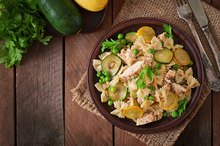Canada's Food Guide and Calorie Counter
Like the United States, Canada provides food recommendations to help improve the dietary intake of its citizens. Based on scientific evidence, Canada's Food Guide is meant to provide nutrient standards for Canadians and help prevent chronic disease. It also acts as a guide to help Canadians know what to eat and how many calories to consume each day.
History of the Food Guide
Formally known as the Official Food Rules, Canada's Food Guide was first introduced in 1942, according to Health Canada 1. Its purpose at that time was to help Canadians meet nutrient needs during wartime food rationing. Since then, the guide has gone through many names, but its purpose has remained the same: to "help everyone in Canada toward the health that comes from eating the right foods."
The Food Groups and Pattern
What Can You Eat on Michael Thurmond's Diet?
Learn More
Canada's Food Guide is divided into four food groups: fruits and vegetables, grain products, milk and alternatives, and meat and alternatives. The plan also includes a certain amount of fat and oils. The food groups are divided into an eating pattern -- meaning the number of servings you should have from each group -- based on age and gender. Food choices and eating patterns are derived using extensive scientific research and are meant to ensure nutrient needs are met and chronic disease is reduced.
- Canada's Food Guide is divided into four food groups: fruits and vegetables, grain products, milk and alternatives, and meat and alternatives.
- The food groups are divided into an eating pattern -- meaning the number of servings you should have from each group -- based on age and gender.
Calories for Canadians
In addition to what to eat, Canada's Food Guide also provides reference information for calorie needs 1. The estimated energy requirements for Canadians are dependent on age, gender and activity level. For example, a 30-year-old woman who is "low active," which means she gets some activity through the course of her day by walking to the bus or shoveling snow, needs 2,100 calories a day to maintain a healthy weight. Health Canada notes that calorie requirements are estimations, and your individual calorie needs may vary based on your body composition, genetics and body size.
- In addition to what to eat, Canada's Food Guide also provides reference information for calorie needs 1.
- Health Canada notes that calorie requirements are estimations, and your individual calorie needs may vary based on your body composition, genetics and body size.
Nutrition Tools for Canadians
What Are the Weight Watchers Points for a Publix Cupcake?
Learn More
As the organization responsible for promoting nutritional health and well-being in the nation, Health Canada offers a number of tools that Canadians can use to help them understand and utilize the food recommendations. The Health Canada website provides links that explain the basics of the guide, including how to choose foods, use the guide and maintain healthy habits. The website also features a tool that allows you to create your own customized food guide to meet your personal dietary needs.
Related Articles
References
Writer Bio
Jill Corleone is a registered dietitian and health coach who has been writing and lecturing on diet and health for more than 15 years. Her work has been featured on the Huffington Post, Diabetes Self-Management and in the book "Noninvasive Mechanical Ventilation," edited by John R. Bach, M.D. Corleone holds a Bachelor of Science in nutrition.








